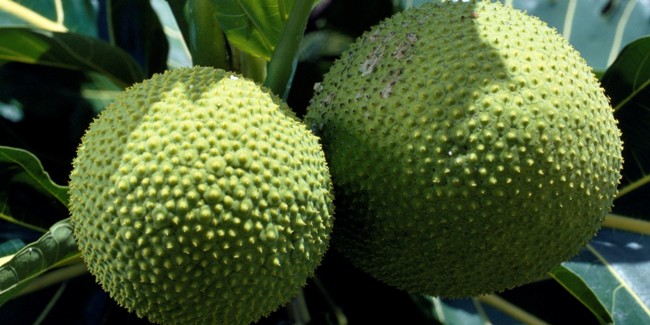Starting A Lucrative Breadfruit Farming and Export Business In Nigeria

An increase in every society’s population demands an equal rise in the food supply. Nigeria’’s population is constantly growing, and so, necessitates a continuous expansion of its food sources to meet the health and dietary needs of the people living in the country—with crops like Breadfruits having the potential to become one of the food sources that will also feed millions of people.
Unfortunately, breadfruit production in Nigeria is at an all-time low. Underused and unexploited, its market value has gradually declined.
Recent studies reveal that breadfruit is now an endangered food species in Nigeria. For a crop that thrives and perfectly adapts to tropical regions like the one in the country, this reveal is alarming, prompting crucial steps to be taken in order to rectify the situation.
Breadfruit farming and production is one guaranteed means of earning profits and providing great food supply in Nigeria because of its untapped market potential, high yields, and nutritional value.
What is Breadfruit Farming and Production About?
Breadfruit farming is everything that has to do with the planting, management, and harvesting of the various types of breadfruits.
A member of the Moraceae family and genus of Artocarpus, Breadfruit is a fruit tree that does excellently in the tropics. Its trees attain over 98 feet in height and produce delicious large fruits. Depending on the variety, fruits are rounded/elliptic and seed/seedless. The peculiarity of its fruit revolves around the fact that it’s very edible at any time- unripe or ripe.
Seeds from breadfruits are quite popular in the eastern part of Nigeria. The Ibos call it ‘ukwa—a porridge meal made with the seeds. Other breadfruit-grown states are Delta, Edo, and Oyo. It’s called ‘Afon’ in the South-Western part of Nigeria, ‘Bafafuta’ in the Northern part of Nigeria, and ‘Ize’ by the Binis’.
High yields of at least 600-700 Breadfruits per tree make it valuable to farmers and agropreneurs in most tropical regions of the world. Other parts such as the bark, tree wood, leaves, seeds, and flowers are also beneficial to humans as medicines, building materials, and animal feed. All these added benefits increase its marketability.
Business Opportunities In Breadfruit Farming And Production Around The World
Breadfruit farming should be studied and invested in because it is a great avenue for Nigerian farmers to earn considerable income for a long time.
Tree plants like breadfruits last for years and do not need annual replanting like non-tree crops do. Replanting of breadfruits over another acre of land only increases the yields and financial gains once the trees reach maturity.
Some of the business opportunities of breadfruit farming and production include:
1). Source Of Food:
Breadfruit consumption is most prominent in the southern-eastern part of Nigeria. The seeds are extracted and cooked as a delicious porridge meal called ‘ukwa’. Seeds of the Treculia africana (a genus of the breadfruit family) are most sought after in the South Eastern region and sold in cups by hawkers and traders. Breadfruit is also a staple food to the people of Edo, Delta and Oyo states.
The nutritional value of this fruit is very high. Enriched with proteins, potassium, fibre, carbohydrates, and vitamins such as vitamins A, C, and K, it’s every health-focused person’s dream fruit.
Diabetics and cardiovascular patients are advised to add meals like Breadfruit to their diet plans. The potassium and fibre it contains treats and manages symptoms of those ailments. Roasted, boiled or made into porridge, it can be eaten in any form. Even its raw form is edible. Flour is produced from ground seeds and the soft, fleshy parts are a good substitute of yam and potatoes.
2). Wood production:
Multipurpose in nature, the tree of this tropical fruit produces lightweight, termite resistant wood. Furniture, roofs, and canoes are built with wood from the fruit’s tree. When processed into wood pulp, it converts to paper. The lightweight wood is appreciated by carvers and some furniture designers. Other ways it can be used are in firewood and charcoal production.
3). Herbal Medicines:
Breadfruit produces natural herbal medicines for different ailments and diseases. Roots and leaves from the tree are taken orally to relieve and treat diseases like diabetes, heart diseases, asthma, gout, backache, and fever.
People who suffer from skin infections and problems like burns, rash, boils and herpes apply the roots and leaves to the affected parts of their skins. It’s also a treatment for ear infections or eye ache.
4). Latex:
Latex extracted from the bark of the fruit tree has been proven to be as effective as chemically manufactured glue. It has good commercial value as a natural caulking agent.
5). Animal Feed:
Breadfruit is as edible and nutritious to animals as it is to humans. The bran and head pulp of the fruit is processed into animal feed while leaves from the tree provide good fodder to herbivorous farm animals.
Facts and Benefits of Breadfruit Farming and Production
Breadfruit trees grow up to 98 feet in height and are one of the high yielding plants known to man. Each tree in a breadfruit plantation yields at least 200 fruits.
The fruits are round or oval, about six to eight inches long and eight inches in diameter.
Unripe fruits are plain green. When ripe, it turns pale green with reddish-brown spotting.
Male and female flowers (Monoecious or Dioecious) sprout from the tree at maturity. Male flowers sprout days before females’ flowers. Burning male flowers will release powerful mosquito repellent.
Yield can be as high as 600-1200 fruits per fully grown tree. One of those fruits would weigh 2 to 55kg.
The plant has the ability to thrive in neutral, alkaline or saline soil.
Wood from the tree is a source of latex for glues, firewood for cooking and heat, furniture and roof building wood, and wood pulp for paper.
Breadfruit can be eaten raw in fruit form or cooked/roasted. It can serve as a good substitute for yam or potatoes.
Tree leaves or pulp heads of this fruit are excellent animal feed.
Varieties of breadfruits are either seedless or seedy. The seeds are cooked as porridge meals or ground into flour.
An Unripe breadfruit is hard and starchy. When ripe, it’s white, starchy and soft.
Parts like the leaves and roots are medicinal. They are herbal remedies to aid digestion, treat skin infections, control diabetes, and promote good hair growth.
Breadfruits are mainly cultivated with their seeds or shoot/cuttings of the root. Young trees are partial to shading. Mature ones need good doses of sunlight.
Maturity for breadfruit trees cultivated with seeds spans over 5-10 years. Root-shoot/cutting propagated trees only need about 3-6 years to reach maturity.
See Also: How To Start A Lucrative Quail Farming Business In Nigeria: The Complete Guide
Types Of Breadfruits
The three primary genus of breadfruit (Moraceae) family are: Breadfruit (Artocarpus altilis) ; African breadfruit (Treculia Africana); Jackfruit (Artocarpus heterophyllus)
All around the world, breadfruit is cultivated by genus. Each genus is grown in tropical areas with suitable ecological conditions. Some genus adapts well to the western parts of the world but for others, Asia and Africa are the only continents in which they can thrive.
1). Breadfruit (Artocarpus altilis):
The Artocarpus altilis of the breadfruit family is a native of Central America, Southeast Asia, the Pacific Ocean, South Asia, Caribbean, and Africa. Mature breadfruit trees stand over 85 feet tall, are monoecious (possess male and female flowers on the same tree) and have large, thickset leaves. Yields are weighty—4 to 6 kg and lemon-green when ripe.
As an ultra-tropical plant, the ecological conditions for excellent growth are 16-38 degree Celsius followed by an annual rainfall of 78.7-98.4 inches. Usually, it thrives in soils that are fertile and properly drained, but some subspecies adapt to shallow, sandy or saline soils.
This genus is a source of food, wood and animal feed. Cooked breadfruit has a potato-like state and looks like soft bread. Roofs and canoes are built from the wood of its trees.
2). African Breadfruit (Treculia Africana):
African breadfruit is a genus of the breadfruit family (Moraceae) and is similar to the actual breadfruit plant. It is the type of breadfruit found in Madagascar, west, and central Africa. Unlike the breadfruit, Treculia Africana is mostly cultivated for its edible and numerous seeds. Each fibrous and hard fruit weighs up to 8.5 kg and contains 200 kg of seeds. Ripe African breadfruits have green-yellow skin and a tough texture. The fruit pulp of this genus is not a food source but can be used as herbal medicine.
Edible seeds are used for the Ibo delicacy called ‘ukwa’. It can also be roasted or fried as is done in other parts of the country and world. The 200kg of seeds per fruit is a large amount of yield considering how sought after it is.
Treculia Africana is cultivated in forested and wet areas such as the south-east, west and south-south parts of Nigeria. Other countries were it thrives are Uganda, Zambia, and Madagascar. It grows about 1,494m above sea level.
Maturity lends trees a height of 30m (98 feet). Creamy latex pours out of the bark of these mature trees and is used as glue for caulking or herbal medicine for mending broken bones. Male and female flowers sprout from trees but do so separately making them dioecious in nature. A single tree of African breadfruit bears flowers of only one gender.
Several subspecies of this genus include Treculia Africana var. mollis, Treculia Africana var. illicipolia, Treculia Africana subsp Africana, and Treculia Africana var. inversa.
3). Jackfruit (Artocarpus heterophyllus):
Jackfruit is a part of the breadfruit family and produces the largest fruits of them all. This tropical fruit is very popular in south India and some Asian countries like the Philippines, Malaysia, Sri Lanka, Bangladesh and the state of Kerala in India. Fruits from this genus weigh up to about 121 pounds, 50 cm across and 35 inches long.
One jackfruit tree yields 150-200 fruits annually and grows up to 80 feet in height. Similar to Breadfruit (Artocarpus altilis), it is monecious- flowers of both genders sprout from the same tree. The large flowers of jackfruit trees are edible.
Areas plagued with high winds or above 4,000 feet (sea level) are unhealthy for jackfruit trees and result in either death of trees or low yields. Seeds are the best propagating option for jackfruit. Trees planted by seeds will mature quicker than other propagative option.
How To Start Breadfruit farming And Production: A Step By Step Guide
1). Choose A Breadfruit Genus:
Before cultivation, decide and pick out the specific genus of breadfruit you are interested in. Your decision should not be random. The genus most adaptable to Nigeria is Treculia Africana—African breadfruit. It would take a lot more effort and care to cultivate a genus like a jackfruit. Treculia Africana—perennial plant, takes 3-5 years to mature and its edible seeds are what most Nigerians seek.
2). Planting Date:
Like most breadfruits, Treculia Africana needs a lot of water. It would not thrive under any other environmental conditions like drought. So it’’s best to plant seeds or root cuttings from March to June. The temperature during these months ranges from 21 degrees Celsius to 35 to degrees Celsius which is perfect for young plants.
3). Land Selection And Preparation:
Any farmer intending to go into breadfruit farming must consider the area and type of land for cultivation. For instance, some northern states have low annual rainfall and experience drought. Such places should be avoided.
Forested areas are preferable at the earliest stages of growth but mature tree requires full sunlight. The annual rainfall of selected land must fall between 1,250 to 3,000 mm. Map out, clear and til a land with water retentive, fertile and deep soil. Fertile soil and good ecological produce seeds no less than 120kg per tree, each year. A hectare of land would yield 6-10 tonnes of seeds annually.
The soil should be prepared by thoroughly ploughing the soil into a smooth texture. Weeds should be cleared and organic manure added to enhance fertility.
4). Propagation Method:
Seedlings are directly implanted to the tilled soiled or are sown into plant pots. There are other methods of propagation which involve using root cuttings or root shoots from mature trees. Young plants should be partially shaded by trees or man-made shades.
5). Maintenance:
Fertilize tree base using 7.10.15 N.P.K measurements (ratio).
Irrigate soils when it begins to lose moisture or when the weather condition becomes unfavourable.
Boom spray, Bordeaux 1% to check for rotting fruit disease.
Weed control should be applied prior to planting and during growth.
6). Harvest:
The speed of growth of Breadfruits depends on the soil choice, propagating methods, and ecological conditions. If all or some are favourable, the perennial plants can grow into maturity in 2-4 years. Typically, the trees bear fruits 3-6 years after planting. It is recommended that harvesting is done a week after flowering. Harvest is usually manual- plucked with hands or sickle.
After harvest, the seeds are dried, stored and sold at local markets or processed into flour or oil.
Challenges Of The Breadfruit Farming and Production Business
The decline in breadfruit production is due to certain challenges that farmers face. These challenges include:
Lack of adequate land for breadfruit farming.
The stress of manually de-pulping (extracting seeds) fruits.
Frequent bushfires that destroy trees and forests.
Large tree sizes create difficulty in acquiring sufficient land.
Safety hazards breadfruit sizes pose to farmlands, passers-bys, and farmers.
See Also: How To Start A Lucrative Beans Farming Business In Nigeria: The Complete Guide
Conclusion
Despite the decline in production, breadfruit is still one of the tropical food plants capable of providing considerable profits for farmers.
To harness the fruit’s full potential, farmers should carefully study, select, and cultivate the type of breadfruit most suited to Nigeria’s ecological conditions. Furthermore, it’s important for farmers to choose the propagative method that matches their desired planting to harvesting timetable.
Apart from serving its purpose as a profitable food crop for farmers, breadfruits in their entirety; tree, seeds, bark, fruit pulp, and flowers all have different uses to humans. It is a source of latex, mosquito repellent, oil, and baking flour. These by-products are all great business opportunities for breadfruit farmers and producers.








